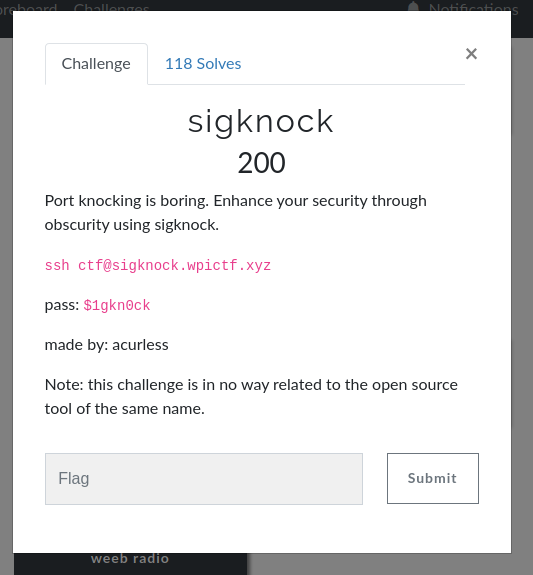Writeup for WPICTF Sigknock challenge
ctf21 Apr 2020
4 minute read
WPICTF Sigknock #
I recently attend my first ctf (where my team was 14th!), It was an awesome experience and I really liked the thrill of it. I especially liked one of the linux challenges named $1gkn0ck:

So I started by researching what Port Knocking was, and I found out it’s a way of opening and closing ports on a machine by sending a pre-defined sequence of connection attempts. This helped me later to crack the puzzle.
So I sshed into the VM, and didn’t notice anything at first. But then I noticed something interesting in the processes:
~ $ ps aux
PID USER TIME COMMAND
1 wpictf 0:00 {init_d} /bin/sh /bin/init_d
6 wpictf 0:00 /usr/bin/irqknock
7 wpictf 0:00 /bin/sh
9 wpictf 0:00 ps aux
~ $
There was an interesting program conveniently named irqknock. When I launched the program, nothing was happening until I started fiddling around and noticed that when I inputted CTRL+C, the program would react:
~ $ irqknock
^CGot signal 2
State advanced to 1
I then realized that the program only reacted when you triggered a signal interrupt like CTRL+C or CTRL+Z. So I needed to find the right sequence of signal interrupts that would trigger the program like port knocking to make it give me the flag. Seeing the big list of 64 Unix interrupts, I decided to run a bash script to find the ones that made the program react:
#!/bin/sh
for i in $(seq 1 64)
do
echo $i
/usr/bin/irqknock &
sleep 1
kill -$i $!
echo $!
done
This program starts irqknock as a daemon and then sends it a signal interruption command with kill. It echoes the output to the console so I can see if the program has reacted to my nudges.
This was the output:
~ $ #!/bin/sh
~ $ for i in $(seq 1 64)
> do
> echo $i
> /usr/bin/irqknock &
> sleep 1
> kill -$i $!
> echo $!
> done
1
12
2
14
3
Got signal 2
State advanced to 1
16
4
Got signal 3
State advanced to 0
18
5
20
6
22
7
24
8
26
9
28
10
30
11
32
12
Got signal 11
State advanced to 0
34
13
36
14
Got signal 13
State advanced to 0
38
15
40
16
42
17
44
18
Got signal 17
State advanced to 0
... # snipped for brevity
This script revealed exactly which signals could induce a reaction: [2, 3, 11, 13, 17]
With this information, I tried sending these signals to irqknock in a linear order:
~ $ irqknock # start new irqknock instance
^Z[2]+ Stopped irqknock
~ $ bg
[2] irqknock # retrieve pid of new instance
~ $ ps aux
PID USER TIME COMMAND
1 wpictf 0:00 {init_d} /bin/sh /bin/init_d
6 wpictf 0:00 /usr/bin/irqknock
7 wpictf 0:00 /bin/sh
10 wpictf 0:00 irqknock
80 wpictf 0:00 irqknock
81 wpictf 0:00 ps aux
~ $ kill -2 80 # send signals in linear order
~ $ Got signal 2
State advanced to 1
~ $ kill -3 80
~ $ Got signal 3
State advanced to 2
^C
~ $ kill -11 80
~ $ Got signal 11
State advanced to 3
~ $ kill -13 80
Got signal 13
State advanced to 4
~ $ kill -17 80
Got signal 17
State advanced to 5
WPI{1RQM@St3R}
As you can see, it worked! These signals made the program react and send me back the flag in WPI{...} format.
Big thanks to acurless who made this epic challenge!=
Copyright © 2019-2025 uzpg